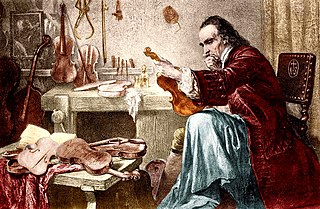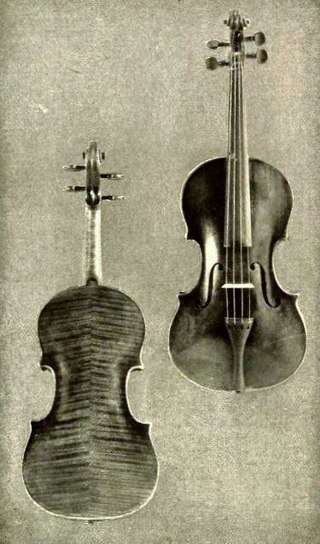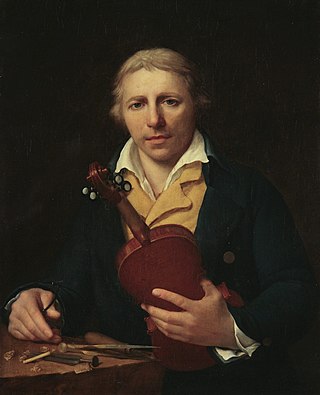
Antonio Stradivari was an Italian luthier and a craftsman of string instruments such as violins, cellos, guitars, violas and harps. The Latinized form of his surname, Stradivarius, as well as the colloquial Strad are terms often used to refer to his instruments. It is estimated that Stradivari produced 1,116 instruments, of which 960 were violins. Around 650 instruments survive, including 450 to 512 violins. His instruments are considered some of the finest ever made, and are extremely valuable collector's items.

A Stradivarius is one of the violins, violas, cellos and other string instruments built by members of the Italian family Stradivari, particularly Antonio Stradivari, during the 17th and 18th centuries. They are considered some of the finest instruments ever made, and are extremely valuable collector's items.

Jean-Baptiste Vuillaume was a French luthier, businessman, inventor and winner of many awards. His workshop made over 3,000 instruments.
The Soil Stradivarius of 1714 is an antique violin made by Italian luthier Antonio Stradivari of Cremona (1644–1737). It is one of 700 known existent Stradivari instruments. The instrument was made during Stradivari's "golden period" and is named after the Belgian industrialist Amédée Soil. The current owner of the violin is violinist Itzhak Perlman.

The Lipinski Stradivarius is an antique violin constructed in 1715 by the Italian luthier Antonio Stradivari of Cremona, during Stradivari's "golden period" between 1700 and 1725. There are fewer than 650 extant Stradivarius violins in the world today, and the Lipinski is considered to be a particularly fine example. In 2012, it was appraised at US$5 million.
The Otto Booth; Cho-Ming Sin Stradivarius of 1716 is an antique violin fabricated by Italian luthier Antonio Stradivari (1644–1737) of Cremona. The original label of the instrument was "Antonius Stradivarius Cremonensis faciebat Anno 1716". The Booth Stradivarius has a two-piece back and has a body length of 35.4 cm.

Bartolomeo Giuseppe "del Gesù" Guarneri was an Italian luthier from the Guarneri family of Cremona. He rivals Antonio Stradivari (1644–1737) with regard to the respect and reverence accorded his instruments, and for many prominent players and collectors his instruments are the most coveted of all. Instruments made by Guarneri are often referred to as Del Gesùs.

The Lord Dunn–Raven Stradivarius of 1710 is an antique violin made by luthier Antonio Stradivari of Cremona (1644–1737). It is one of 700 known existent Stradivari instruments. This violin is currently owned by violinist Anne-Sophie Mutter. The Lord Dunn-Raven was made during the Stradivari's "golden period". The violin is named after the Irish politician Windham Wyndham-Quin, 4th Earl of Dunraven and Mount-Earl.

Nicolas Lupot was one of the most illustrious French luthiers of his time.
The Kiesewetter Stradivarius of circa 1723 is an antique violin fabricated by Italian luthier Antonio Stradivari of Cremona (1644–1737). The instrument derives its name from its previous owner, German composer and violinist Christophe Gottfried Kiesewetter (1777–1827).

Hottinger Collection – formed in New York City by Henry Hottinger.
Arthur Edward Smith, known as A. E. Smith, was an English-born Australian violin and viola maker whose violins and violas are prized for their 'excellence of tone' and 'decorative elements'. According to some musicians, "it is his violas that have the greatest reputation, being easily counted amongst the greatest ever created, regardless of era or nationality."
Giuseppe Giovanni Battista Guarneri, better known as Giuseppe filius Andrea Guarneri was a violin maker from the prominent Guarneri family of luthiers who lived in Cremona, Italy.
Rembert Wurlitzer Co. was a distinguished firm in New York City that specialized in fine musical instruments and bows.
Machold Rare Violins, domiciled in Bremen, was the global market leader in the historic string instruments trade.

The Violin Museum, formerly the Stradivarius Museum, is a musical instrument museum located in Cremona. The museum is best known for its collection of stringed instruments that includes violins, violas, cellos, and double basses crafted by renowned luthiers, including Antonio Stradivari and Giuseppe Guarneri del Gesù.
Vincenzo Rugeri, was an Italian luthier of string instruments such as violins, cellos, and, violas in Cremona, Italy. His instruments are noted for their craftsmanship and tone quality. Vincenzo came from a distinguished family of luthiers, the first of whom was his father, Francesco Rugeri. Despite the local tradition of artisan families laboring together through generations, Vincenzo left the family shop and set up a successful shop of his own in the center of Cremona. Vincenzo was the third son of luthier Francesco Rugeri. Vincenzo's work, like Francesco's, is influenced by Nicolò Amati's Grand Pattern model, however Vincenzo's work was distinguished from his father's by utilizing a lower arch inspired by Antonio Stradivari. An analysis of the body of his work reveals that the quality of Vincenzo's instruments is remarkable, perhaps even more so than his father's. Vincenzo's instruments, though less numerous, are valued at least equal to those of his father. A violin by Vincenzo Rugeri realized $502,320 on October 3, 2011 at Brompton's Auctions in London. Carlo Bergonzi was a distinguished apprentice of Vincenzo Rugeri.
Antonio Stradivari (1644–1737) was an Italian luthier and craftsman of string instruments
Bein & Fushi, Inc. is a stringed instrument dealership and repair shop in Chicago founded in 1976, known internationally for its dealership of antique string instruments such as those made by luthiers Antonio Stradivari and Giuseppe Guarneri. Bein & Fushi includes the Stradivari Society, known for lending rare violins to young aspiring artists.








